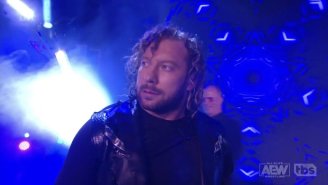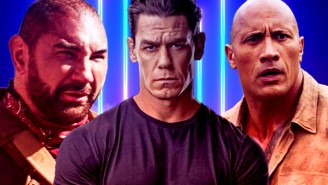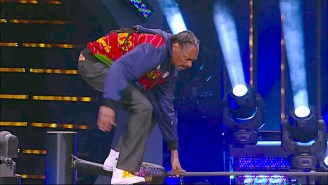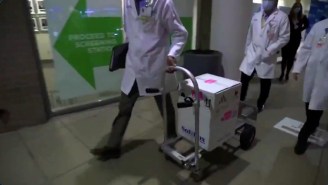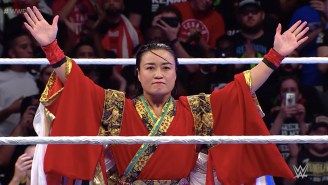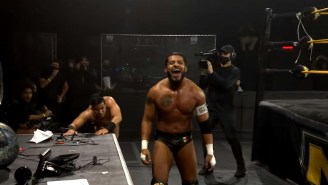Hulk Hogan has said a lot of despicable stuff in his life, but among the most shameful things to come out his mouth is his claim that André the Giant died only days after their legendary WrestleMania III showdown. Like a lot of crazy things Hogan has said, it’s almost become accepted canon, even though it’s not even close to true. The fact is, André lived for almost another six years before passing away on January 27, 1993. Most informed wrestling fans know this, and yet André’s final years often go ignored, with most bios treating WrestleMania III as the final big event of his life.
The reality is, André continued to wrestle, live large and rack up impressive achievements right until the final bell. Here’s a few interesting facts about the part of André the Giant’s story that often goes untold…
André’s minute with the WWF World Championship was the only singles title reign he ever had.
Despite being dead, André the Giant somehow managed to hit one last major career peak after WrestleMania III. On February 4, 1988, André would win the WWF World Championship from Hulk Hogan on the NBC network TV special, The Main Event. The win was a tainted one, as André won thanks to evil ref Earn Hebner and then immediately handed the belt over to Ted DiBiase, leading to the title being vacated. That said, André did officially win the title, and he did it in front of a massive audience – The Main Event drew an absurd 15.2 rating and 33 million viewers, making it the most-watched pro wrestling event in history.
Unbelievably, the WWF Championship, which André held for all of one minute, was the only singles title of his career. He won a variety of tag team championships during his time in wrestling, but nobody wanted to put a singles belt on him as he was generally pushed as a special attraction rather than a title contender. But hey, it doesn’t matter much if you only win one championship, as long as it’s the big one.
The Giant’s last American television appearance was for WCW.
André the Giant was a WWF man through and through, wrestling almost his entire career for the company. In the ’70s, André traveled around the world competing in various territories, but he was managed by Vince McMahon Sr., who lent him out to these other promotions for a fee. Once Vince McMahon Jr. took over and transformed the company into a global empire, André remained an exclusive WWF commodity.
But the early ’90s, André had deteriorated to the point where even tag matches were physical torture, and at SummerSlam ’91, he made his last WWF on-air appearance, managing the Bushwhackers in a match against the Natural Disasters. WWF and André parted ways, but the Giant wasn’t done with wrestling, making his final U.S. television appearance for WWF’s bitter arch rival, WCW.
The curtain call came in September 1992 at Clash of Champions XX, which featured a number of WWF stalwarts showing up to cash a WCW check, including Bruno Sammartino and André. The sight of André the Giant being interviewed by Tony Schiavone and hanging out with Teddy Long on WCW television was more than a bit bizarre, but getting to see the Giant on TV one more time was worth the cognitive dissonance for most fans.
André ended his career wrestling in Japan and Mexico.
https://www.youtube.com/watch?v=EoGc1bOyT3U
André wasn’t just making WCW red carpet appearances during the last couple years of his life; he continued to wrestle a full schedule, as well. Most of his final in-ring appearances involved him tagging with fellow wrestling Goliath Giant Baba in All Japan Pro Wrestling. André had to place both hands on Baba’s shoulders to steady himself as he made his way to the ring, and he spent most of his time on the apron, but once he tagged in, he still gave audiences everything his failing body would allow. Even though he would work, at most, a couple minutes per match, André could often barely move for a day or more after wrestling.
André would continue to wrestle right until the end, having his final match in December of 1992, barely more than a month before he would pass away (you can watch a clip of his second-to-last match, above). Wrestling was André the Giant’s life, and he continued to wrestle until that life was no more.
He mainly drank to manage his pain, and rarely ate to excess.
There are a lot of incredible stories about André the Giant floating around, and the majority of them are about two things – drinking and eating. We’ve had some fun with these stories ourselves. Tales of him downing more than 100 beers in a sitting or chowing down on a dozen steaks and lobsters in a single meal are legendary, but according to those closest to him, he wasn’t really the ravenous beast he’s been built up to be.
André did drink a lot, more towards the end of his life, but he did so as a way of treating the pain inflicted by his acromegaly, the progressive syndrome caused by the excess growth hormone in his system. André was scornful of drugs and painkillers, and given his size, they likely wouldn’t have had much effect anyways, so he instead self-medicated with truly astounding amounts of booze.
As for the food, that was mostly André showing off. He could pack it away if he wanted, but most of the time, he preferred regular portions. According to former WWF referee Tim White, who was André’s longtime driver and handler, the Giant would always insist restaurants give him the exact same portions White got. André was also a fan of yogurt, and as a visual gag, he’d make a show of eating the smallest, daintiest cups he could find.
He became obsessed with home shopping in his later years.
Now, I don’t want to give the impression that André’s final years were all pain and misery. As his career began to wind down, André got to spend more time in his favorite place in the world, the AFJ Ranch in North Carolina, where he raised longhorn cattle, tore around on ATVs and kicked back in one of several custom-made, giant-sized recliners. It was during his final years that he also discovered a new passion – buying crap from QVC.
Not wanting to attract crowds, André never had the opportunity to go shopping, sending handlers out to buy things for him instead. But now, with the discovery of home shopping, he could merrily spend a small fraction of his vast fortune on miracle products, revolutionary cleaning solutions and knives that could cut through car doors. Soon André was living in a nest made of miracle mops and Franklin Mint porcelain figurines, and the Giant couldn’t have been happier about it.
André died in France shortly after attending his father’s funeral.
In January of 1993, André received a call from his family in France – his father Boris was sick, and not expected to hold on much longer. André flew home to see his father one last time. André stayed in France for the funeral and his mother’s birthday.
On January 26, André returned to his hometown, a tiny village northeast of Paris named Molien. He spent the day meeting with old friends, playing cards and no doubt being the larger than life entertainer on last time, albeit on a much smaller stage that usual. That night, André died of congestive heart failure in his sleep in his Paris hotel room. He was 46.
André left his entire estate to the daughter he barely knew.
For the most part, André lived his life on his own terms and without apology, but in his later years, he began to regret his fractured relationship with his only daughter. Robin Christensen Roussimoff’s conception was something of a miracle — those afflicted by acromegaly are usually sterile, and yet Robin made her entrance into the world in 1979. André and Robin’s mother Jean had a chilly relationship, and the Giant spent most of his life on the road, so he only briefly saw his daughter a handful of times when the WWF happened to be passing through town. An attempt was made to arrange a visit to André’s ranch, but Robin, then only 10 years old and understandably wary of leaving home to stay with a strange giant, decided not to go at the last second. She wouldn’t get another chance while André was alive.
When André died, only three people were named in his will. He left a flat sum to the caretaker of his ranch and his caretaker’s wife, but everything else — his money, his possessions, the rights to his name and likeness — were left to Robin. André couldn’t be a proper father to Robin, but he did leave her a truly lasting legacy.
The WWE Hall of Fame was created solely to honor André the Giant.
Back in 1993, WWF had no particular plans for a Hall of Fame, but when André the Giant passed away, something truly special had to be done to honor the man who carried the company on his broad shoulders for years. The WWF Hall of Fame was hastily established and in its first year; André was its only inductee, because come on – there ain’t room on the ballot for anybody else when André is on there.
Obviously André never got to give an acceptance speech, but this quote seems like a good substitute, “I have had good fortune. I am grateful for my life. If I were to die tomorrow, I know I have eaten more good food, drunk more beer and fine wine, had more friends and seen more of the world than most men ever will.” Damn straight, boss.
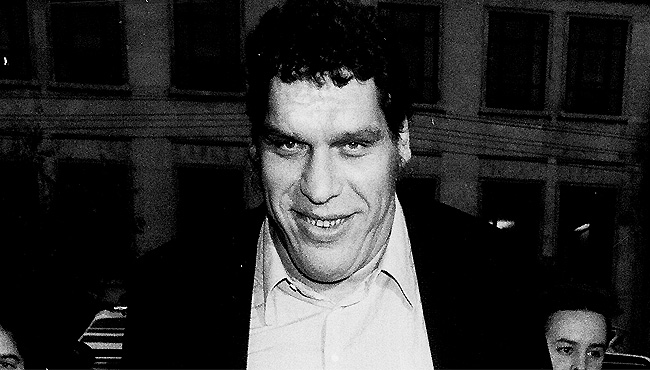
There you are, a few factoids about André the Giant’s last years on Earth. Know any interesting stuff I missed? Have any fond memories of André’s twilight years? Hit the comments and keep it sportsman-like.
via Andre the Giant: Larger Than Life, CBS Sports, True Giants, Camel Clutch Blog, Unbelievable Facts & Wikipedia

